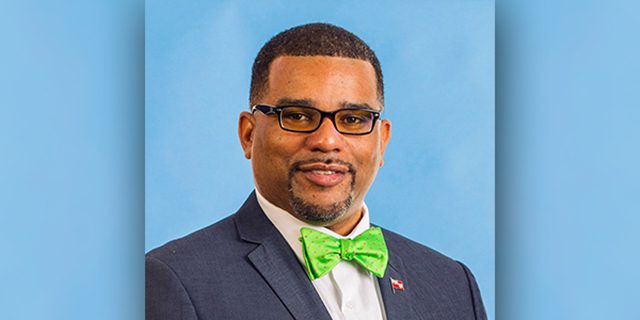[Ministerial statement by Minister of Education Diallo Rabain]
Mr. Speaker, This morning I rise to provide my Honourable colleagues with an update on the planning and related activities undertaken by the Department of Education, in preparation for schools reopening. A System Plan is being developed that comprises four components:
- 1. Planning for reopening – actions needed to resume school operations;
- 2. Preparation of School Buildings – plans for returning to the building;
- 3. Recovery – transitioning staff and students back into to normalcy; and,
- 4. Implementation of a Hybrid Learning Model – teaching and learning for staff and students who are both in school and at home.
Mr. Speaker, You are aware that the reopening of schools is planned for Phase 3 of the Government’s Phased Opening process. Since Phase 2 of the re-opening process commenced just yesterday, we do not know when Phase 3 will be rolled out, but we do know that a plan must be developed so we are positioned to receive our children back into our schools when the time comes. With this at the forefront, a collaborative effort involving technical officers in the Department, school leaders from the Preschool to the Senior School level, and school staff via their Principals was instituted to obtain input and feedback for the framing of a System Plan for reopening our schools.
Mr. Speaker, Just before the State of Emergency was declared and schools were officially closed, officers in the Department of Education, the Ministry of Health and the Department of Environmental Health were working collaboratively updating guidelines and procedures for schools to follow, when dealing with a Pandemic. This collaboration continued during the “Shelter in Place” via telephone conferencing and Zoom meetings in that the Health Officers have played a pivotal role in providing expert guidance and support in developing safety and health protocols for schools. Their leadership, commitment and technical support have been exceptional.
Mr. Speaker, I will now share with my Honourable colleagues more in-depth information about the details of the System Plan for reopening schools. However, let me first say that the Commissioner of Education, my Permanent Secretary, and myself have spent countless hours during the past weeks researching and sharing articles of literature to read on best practices for school reopening. It is important that the System Plan for our public schools is both comprehensive and thorough. As such, we are pleased to report that the System Plan was framed using accreditation standards and indicators of quality as a guide. Best practices were gleaned from school reopening literature about international school jurisdictions such as New Zealand, Denmark and Taiwan. The Plan was also developed from guidelines outlined by international organizations such as UNESCO, CDC, OSHA and the WHO.
Mr. Speaker, The planning for a System Reopening Plan is a mammoth task and involves extensive considerations and factors that must be embedded in a strategy to ensure schools are safe for both students and school staff. In gathering data, our Union stakeholders were invited to provide us with their input. I was most pleased with the questions posed, comments made, critical observations highlighted, suggestions and recommendations put forth by our union stakeholders. It was a good meeting and the additional information received helped to shape the System Plan even more.
Mr. Speaker, I must emphasize the importance of data to make sound and effective decisions. Therefore, in order to plan well, surveys were launched by the Department to obtain data from parents and school staff. In light of COVID-19, we are cognizant that several students and staff may be at risk returning to school. Thus, the Department sent out a brief survey to our parents to obtain potential numbers of children who would return should schools reopen.
Mr. Speaker, Although some thought this survey was a bit premature without knowing the details of the safety and health protocols, we knew that a number of our children may be at risk, and thus there would be parents who would definitely take this into consideration and not send their children back to school. This data was relevant and was needed to help with our planning. Similarly, Mr. Speaker, in order to determine what schools could reopen, the Department had to assess staffing levels. School staff were asked to share if they deemed themselves as vulnerable in alignment with the Ministry of Health guidelines. The data received from school staff thus far, although preliminary, allowed for meaningful projections for potential school reopening.
Mr. Speaker, Parents, Guardians, School staff, the general public and my Honourable Colleagues all want to know what the Department of Education is doing to ensure the safety and health of children. Let’s look at school buildings. The Department has factored in so many considerations as the safety, health and wellbeing of students and staff are of paramount importance. When schools closed in March, our school custodians undertook a thorough deep cleaning process using a deep cleaning protocol guide. This was followed by an inspection check. Since then, Custodians have been working in their respective school buildings three times a week to clean and ventilate the facilities. During the week of May 4th, the Custodians undertook another deep cleaning process of schools, and inspections are presently underway. We are very thankful for the work of the Custodians who play an integral part in ensuring a safe school facility. When we are ready to reopen schools, our custodians will ensure the on-going cleaning and sanitizing throughout the day of highly used surface areas in schools.
Mr. Speaker, Other specific building protocols the Department will be implementing include ensuring a current inventory of hygiene supplies at every school, posting of signs throughout school buildings as reminders of physical distancing, student education on regular handwashing; assessing the layout of classroom spaces to determine maximum occupancy of students; and, posting signs to remind students of entry and exit procedures.
Mr. Speaker, Survey results indicated that many parents want to know the details of the safety and health protocols. I am pleased to report that the Department of Health has developed draft safety and health protocols for the pre, primary, middle levels; and our school for children with special needs – DAME. These protocols define the safety and health actions when students and staff first arrive on the premises. They stipulate how to drop off students at school if arriving by car or motorbike; how they walk up to the building entrance and prepare to enter the building with temperature taking and hand sanitizing stations.
The protocols continue as students and staff move along hallways which will be clearly marked; outline how students engage in learning in their classrooms; sitting at their desks; the procedure to follow when using school bathrooms, during recess snack and lunch breaks; and outdoor play activities. These safety and health protocols, although prepared by the Department of Health, have been vetted by school principals and their school Safety & Health Committees or COVID-19 Response Teams.
Mr. Speaker, These protocols were all pre-tested this week at a preschool, primary, middle school and at our school for children with special needs – DAME. I shared in my Press Statement on Wednesday that the pre-test team comprised the following key stakeholders:
- Department of Education technical officers,
- School Principals for the selected schools,
- School Custodians and the BIU School Custodians Representative,
- Department of Health, Healthy Schools Officer, and School Nurses,
- Bermuda Union of Teachers [BUT] Safety and Health Committee Representatives
Mr. Speaker, The pre-test process was detailed and thorough. The safety and health protocols are generally all the same for schools with some differences for our younger students at the preschool level and students at our special needs school – DAME. When the pretesting of the protocols was undertaken this week, the team was provided with the different sets of protocols for each school as they walked through the school building and began to visualize what the process actually entailed. There were close to 15 persons on the pre-testing team.
Mr. Speaker, The team visited all buildings at each of the selected schools, all floor levels and many classrooms. The team discussed areas such as which entrances the school would use as entry and exit doors; they discussed how the hand washing hygiene would operate, bathroom protocols, physical distancing protocols, what surfaces would require the continuous cleaning, and logistics for different classes. The pretest of the protocols was more exhaustive for our special needs school DAME – as the team visited the therapy room, multi-purpose room, nurse’s room, sensory room, time-away room, all classrooms, and bathrooms. The findings are now being collated and the data will steer what improvements must be made to finalize the protocol guidelines.
Mr. Speaker, The pre testing of protocols will need to be done for every school prior to schools reopening so that they are customized for appropriately for the particular school. Additionally, the Department will undertake audits before any school reopens to ensure that all of the safety measures and protocols have been effected. It is our intent to do what is needed so that when the Ministry of Health advises that it is safe to reopen our schools, then we are ready to received our students, knowing that parents/guardians and school staff are assured it is a safe place for teaching and learning.
Mr. Speaker, I also want to share more about teaching and learning for our students. Our stakeholders are aware that the current remote learning model includes online teaching, learning and services using a variety of applications and platforms; plus the provision of learning packets for students without devices.
At the preschool level, student on-line individual learning with their teacher accounts for 30 minutes face time per day, while on line learning with other students range from one to two hours per day. Our preschool teachers engage in online teaching with three to five students at a time. Teachers also prerecord themselves for students to revisit and reinforce concepts.
Our teachers at the primary and middle school levels are following the essential curriculum to be taught and will focus on teaching students the relevant curriculum standards. On average, our primary school students are spending nine hours per week engaged in remote learning with teachers. Our middle school students are engaged in four 40-minute face to face classes via remote learning with their subject teachers and up to two hours of independent classwork via online platforms, and teacher developed assignments or tutorials for extra support. The time differs for work carried out with Core and Encore teachers.
Mr. Speaker, On Wednesday, I shared with the media and the general public a testament from one of our parents to the work that our teachers are doing. The parent shared that her child’s teacher:
…… covers English, Mathematics, Science and/or Social Studies. The Teacher designs lessons and assignments to be interactive and engages with students through the use of various digital manipulatives and resources such as video storybooks, digital libraries, and STEAM experiments.
Mr. Speaker, I encourage my Honorable colleagues to read the testament from the parent as I included the full submission in my press statement. The Department has also received questions about servicing students who require special or individualized support. Students who require individualized services are students on an IEP [Individualized Education Plan]. Our Learning Support and Specialist Teachers, such as ASD Teachers, who would normally teach and provide services for students when they are in the physical building are now providing remote teaching and services to IEP students individually or in small groups.
Mr. Speaker, Last week I personally participated in a Zoom Assembly with Success Academy at the Heron Bay Primary School. The testimonials from both students and parents were moving. One parent was brought to tears at how well the remote learning was going for their child.
However, Mr. Speaker, As schools move forward with new teaching and learning, it is critical for parents to ensure students are available for online instruction and complete the learner activities. Parents should also check that the work is completed for our students who receive learning packets in the mail.
Mr. Speaker, On Wednesday I shared that at the senior school level, the students are continuing with their regular programme and schedule and are on target for completing their courses. The senior schools are presently following Cambridge’s guidelines for awarding assessed grades to those students who were due to sit IGCSE examinations in May and June.
Let me add that our primary and middle school students are being assessed on an ongoing basis using a variety of assessments. Students have to complete tasks which provide evidence of what they actually know and can do. The work can be a typical assignment like solving a math problem; reading and then writing responses to questions to show understanding; or they may be asked to take a video of themselves doing an experiment or task as evidence that they can actually do it. There are instances when the teacher can see firsthand what students know and can do, via zoom. Other times, students are asked to upload their work as evidence of what they know and can do. I can personally attest to this as I look forward to the notices from the P6 teacher at Elliot Primary School to let me know my daughter’s marked work is available for viewing via Class Dojo.
COVID-19 has required teachers at the primary and middle levels to examine the number of learner standards that remain to be taught for each subject; to identify the most critical standards; and then teach those specific standards.
Mr. Speaker, We applaud our teachers. They are committed to sustaining the remote learning model. It is new but together we will continue to work through improving it as remote learning is becoming part of our new normal.
Mr. Speaker, Let me close by reminding our parents who are returning to work during Phase 2 that the Department is organizing an Education Support Programme for your children while you go to work.
On Monday, May 25th, the Education Support Programme will start for primary and middle school age children. The Preschool Education Support Programme will start on Wednesday, May 27th. All students will continue to engage in the remote learning programme for their respective schools, but at a central venue.
I must emphasize that the Educational Support Programme is only for children whose parents must return to work during Phase 2. Only these parents should contact their child’s school principal. Lastly, we want to assure our parents that physical distancing will be practiced at the Educational Support Programme, as well as implementing safety and health protocols stipulated by the Ministry of Health. We will provide further details about the Educational Support Camp directly to the parents, who have begun to contact the school principals.
Mr. Speaker, We encourage our Educational Family to continue to use the BPSS Family Feedback form to send in their questions, concerns, complaints, and kudos about the work taking place in our schools and at the Department of Education.
Thank You, Mr. Speaker.











